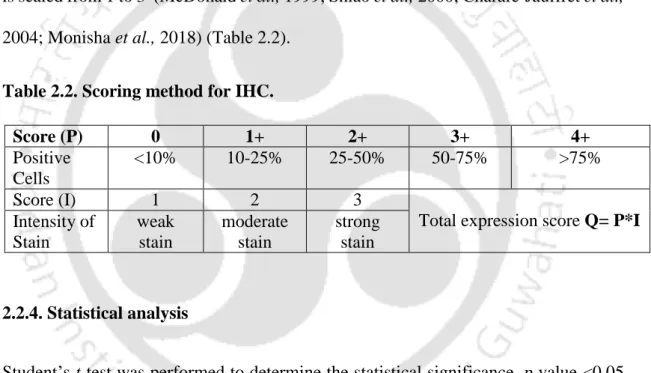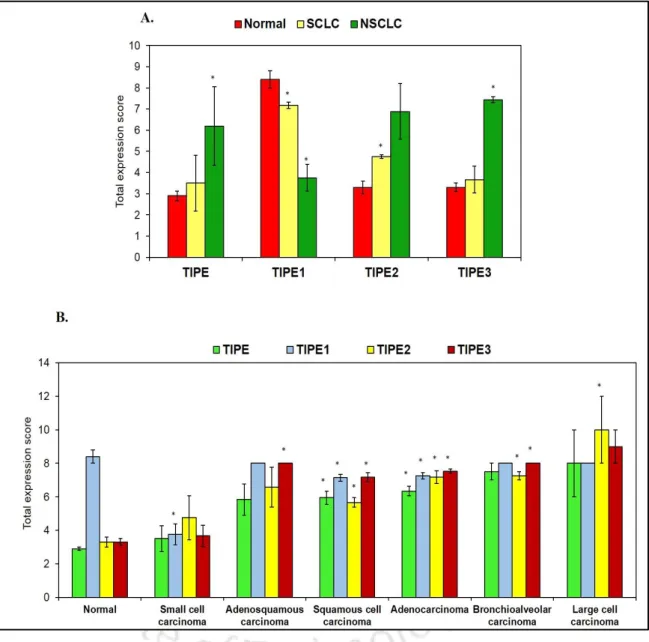Effect of TIPE, TIPE1, TIPE2, and TIPE3 knockout on lung cancer cell migration. Effect of TIPE, TIPE1, TIPE2, and TIPE3 knockout on lung cancer cell invasion.
Introduction
The propensity for early dissemination, the lack of suitable biomarkers and effective therapeutic strategies contribute enormously to the poor survival of lung cancer patients (Bunn, 2002). Therefore, the present study focuses on elucidating the role of this newly identified protein family in the pathogenesis of lung cancer, which would certainly help us to develop effective biomarkers and targets for the management of this cancer.
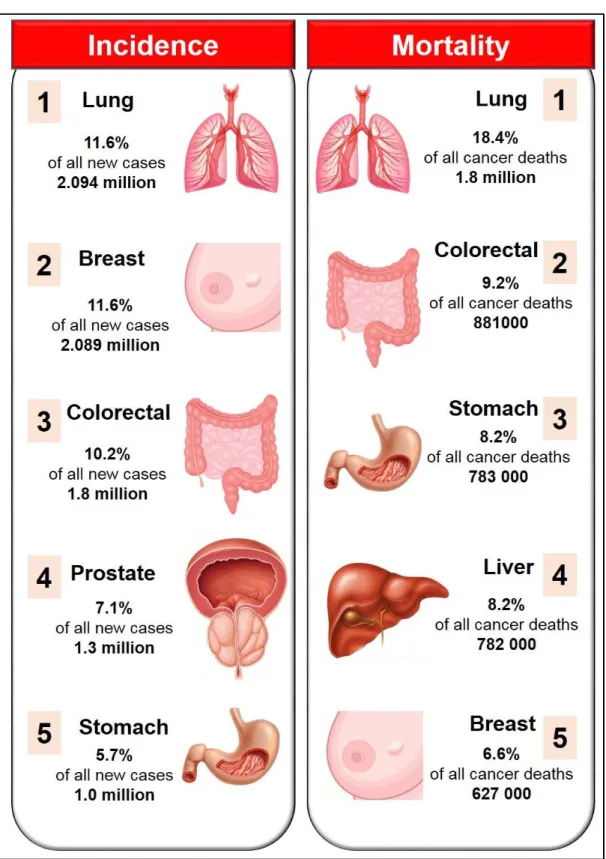
Types of lung cancer
Non-small cell lung cancer
NSCLC represents one of the most genomically diverse types of lung cancer, which presents challenges in both prevention and treatment strategies (Li et al., 2013). Signs and symptoms of the disease may differ between these subtypes based on tumor type and extent of metastasis (Collins et al., 2007).
Small cell lung cancer
Etiology of lung cancer
- Cigarette smoking
- Genetic susceptibility
- Human papilloma virus
- Occupational and environmental risk factors
- Consumption of alcohol
- Diet and food supplements
- Other factors
Individuals with a high dietary intake of fruits or vegetables have a lower risk of lung cancer. Furthermore, patients with HIV/AIDS are known to have a high risk of lung cancer (McErlean et al., 2011).
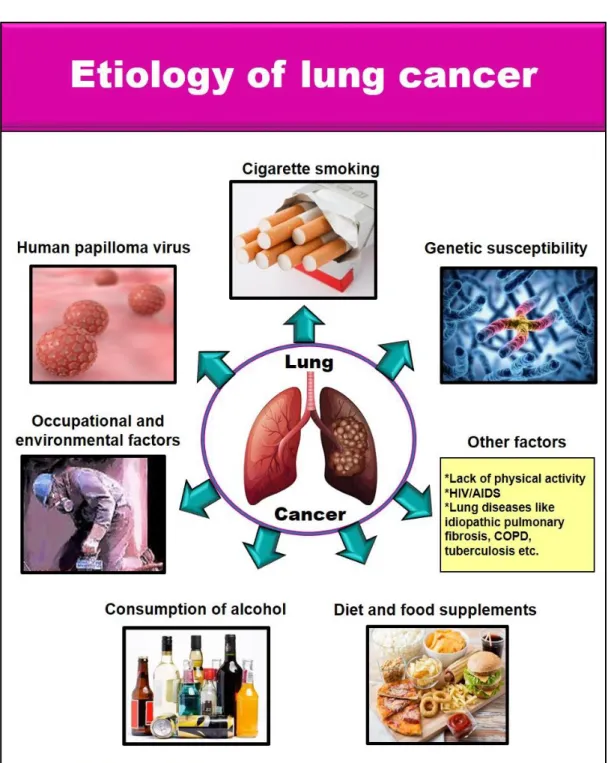
TNM staging of lung cancer
It is also reported that intake of flavonoids, which have strong antioxidant effects, is associated with a reduced risk of lung cancer. Moderate to high levels of leisure-time physical activity are reported to be strongly associated with a reduced risk of lung cancer by approximately 13-30% (Molina et al., 2008).
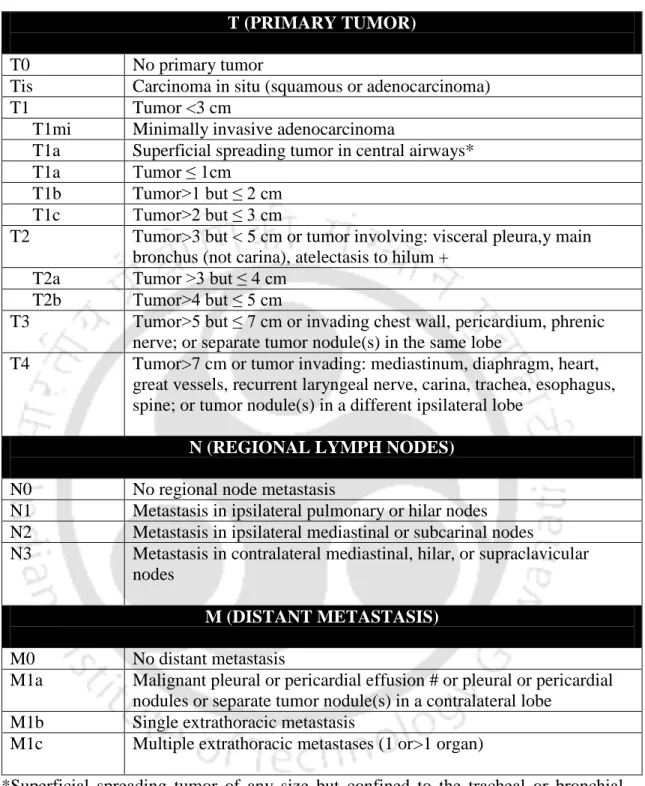
Premalignant and early invasive bronchial lesions of lung cancer
Molecular alterations in lung cancer
Furthermore, genes encoding for different receptor tyrosine kinase (RTK) families were found to be mutated in lung cancer, which include ERBB3, ERBB4, EPHA3, EPHA5, EPHA7, EPHB1, EPHB6, FGFR1, FGFR2, FGFRNT2, NTRK2, NTRK2 KDR etc. Notably, in 57% of NSCLC cases, the hTERT gene was amplified (Lemjabbar-Alaoui et al., 2015).
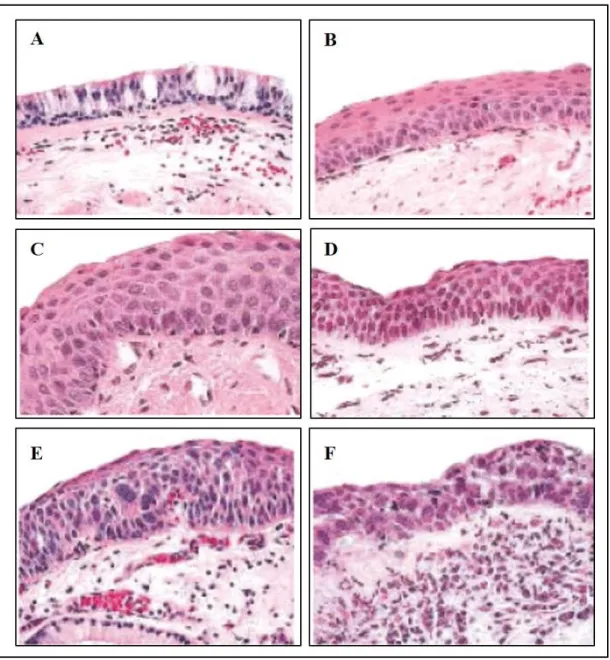
Treatment approaches available for lung cancer
Treatment approaches for NSCLC
In addition, the epothilones, a new class of drugs that include ixabepilone, sagopilone, and patupilone, are also used for the treatment of lung cancer (Chang, 2011). In addition, several vaccines have also been developed for the treatment of NSCLC that target Mucin-1 (MUC1), Melanoma-associated antigen A3 vaccine (MAGE-A3), CimaVax EGF, PRAME vaccine etc.
Treatment approaches for SCLC
Furthermore, various clinical trials are currently ongoing to test the efficacy of other immune checkpoint inhibitors such as anti-PD-1 as monotherapy or in combination with chemotherapy in NSCLC. In addition, several studies have been conducted to evaluate the efficacy of immunotherapy such as BEC2/BCG and INGN-225 vaccines for the treatment of SCLC (Lemjabbar-Alaoui et al., 2015).
Problems associated with lung cancer
Late stage diagnosis
Tumor recurrence
This recurrence can be either locoregional, where recurrence is limited to the treated hemithorax, or distant metastases, where multiple organ metastases are often noted (Caulo et al., 2012). Overall survival time after local recurrence varies widely from 7 to 26 months according to different studies (Fedor et al., 2013).
Development of chemoresistance
In addition, reports indicate that up to 24% of patients have local recurrence after lung cancer surgery, and the risk further increases with the stage of the primary cancer.
TIPE family of proteins
- TIPE
- TIPE1
- TIPE2
- TIPE3
It was found to be highly expressed in inflamed but not normal nerve tissue (Zhang et al., 2009). TIPE3 (tumor necrosis factor-α-induced protein 8-like 3), the newest member of the TIPE family, acts as a transfer protein for the lipid secondary messengers PIP2 (phosphatidylinositol 4,5-bisphosphate) and PIP3 (phosphatidylinositol 3,4,5-trisphosphate) and increases their level in the plasma membrane (Fayngerts et al., 2014; Bordoloi et al., 2018).
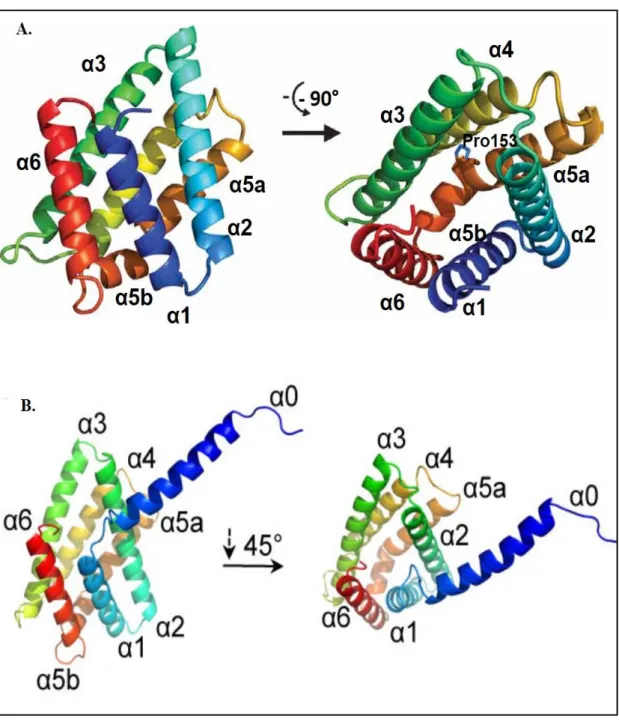
Role of TIPE family of proteins in different cancers
- TIPEs and breast cancer
- TIPEs and cervical cancer
- TIPEs and colon cancer
- TIPEs and endometrial cancer
- TIPEs and esophageal squamous cell carcinoma
- TIPEs and glioma
- TIPEs and gastric cancer
- TIPEs and hepatocellular carcinoma
- TIPEs and non-Hodgkin's lymphoma
- TIPEs and lung cancer
- TIPEs and ovarian cancer
- TIPEs and osteosarcoma
- TIPEs and pancreatic cancer
- TIPEs and prostate cancer
- TIPEs and thyroid cancer
Downregulation of TIPE in tumor cells was found to be associated with decreased expression of matrix metalloproteinase (MMP)-1 and MMP-9, and inhibition of its endogenous expression was strongly associated with decreased expression of vascular endothelial growth factor receptor (VEGFR)-2 in tumor cells (Zhang et al., 2006). In the case of gastric adenocarcinoma, high expression of TIPE levels was observed, which is associated with high metastasis and poor prognosis (Chen et al., 2016).
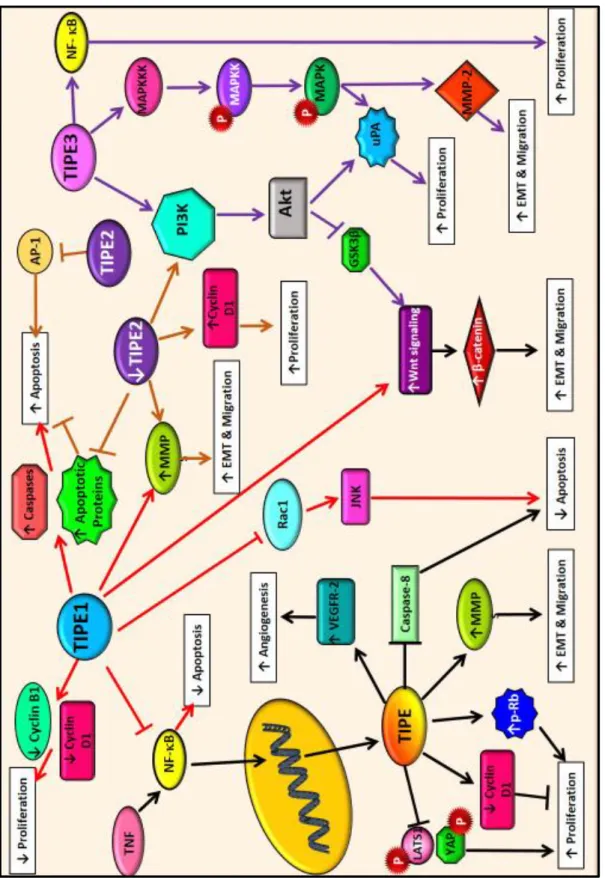
TIPEs and other chronic diseases
In addition, patients with cervical lymph node metastases showed higher TIPE expression than those without cervical lymph node metastases (Duan et al., 2014). In addition to the above, this newly discovered protein family is strongly implicated in various other diseases such as choroidal neovascularization (CNV), restenosis, and metabolic diseases such as diabetes (Bordoloi et al., 2018).
Importance of the study
Furthermore, these proteins exerted their effect against various infectious diseases such as hepatitis B, hepatitis C, listera infection and liver fibrosis. Although this family of proteins plays a crucial role in carcinogenesis, metastasis and development of various human chronic diseases, its exact molecular functions, detailed mechanism of action and the likely cross-talk among the members of this family in lung carcinogenesis, especially tobacco-induced lung cancer, are still unclear.
Objectives
Therefore, a better understanding of the relationship between this important family of proteins and the development of lung cancer, especially tobacco-induced lung cancer, would certainly provide key insights for the development of new biomarkers and effective treatment approaches for the successful management of this aggressive neoplasm.
Introduction
Materials and Methods
- Tissue Microarray
- Tissue Microarray details
- Immunohistochemistry
- Scoring
- Statistical analysis
41 Expression of TIPE proteins in normal lung tissue and different stages of lung cancer tissue was determined by immunohistochemical analysis. The TMA slide contains a total of 75 tissues, 150 cores (duplicate cores from the same patient in all cases) from different individuals: 29 adenocarcinomas, 3 adenosquamous carcinomas, 29 squamous cell carcinomas, 2 bronchioalveolar carcinomas, 4 small cell undifferentiated. large cell carcinoma, 1 neuroendocrine carcinoma and 5 normal lung tissue (Table 2.1).
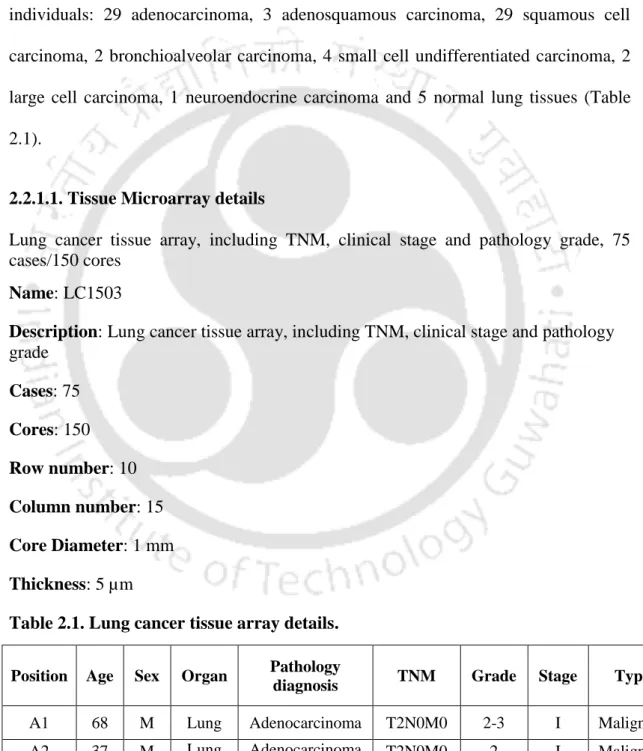
Results and Discussion
- Expression analysis of TIPE, TIPE1, TIPE2 and TIPE3 in human lung cancer tissues
- Expression analysis of TIPE, TIPE1, TIPE2 and TIPE3 in NSCLC and SCLC
- Expression analysis of TIPE, TIPE1, TIPE2 and TIPE3 in different lung cancer pathologies
- Expression analysis of TIPE, TIPE1, TIPE2 and TIPE3 in lung cancer tissues of different age grouped patients
- Expression analysis of TIPE, TIPE1, TIPE2 and TIPE3 in different grades of lung tumor
Representative images of TYPE, TYPE 1, TYPE 2 and TYPE 3 expression in lung cancer tissues. Differential expression of the TIPE family of proteins in different stages and stages of lung cancer.
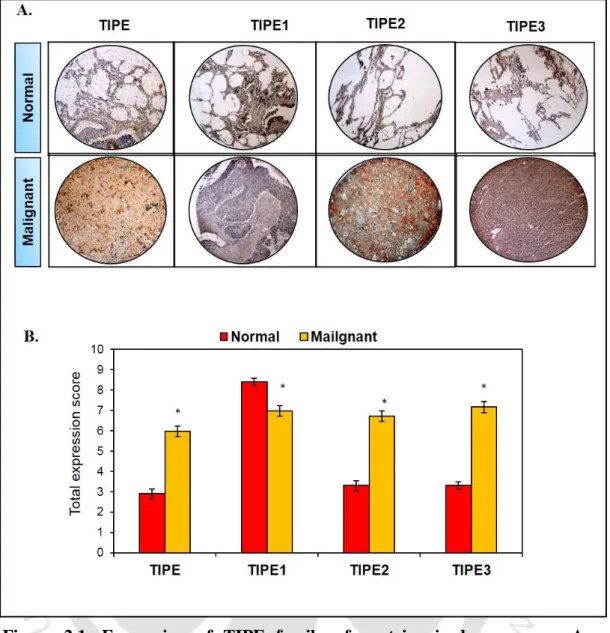
Conclusion
However, in our finding, no significant difference in the expression of the TIPE family of proteins between grades 1, 2 and 3 was observed.
Introduction
However, the role of tobacco components in regulating the expression of TIPE family is not studied to date. As from the previous study, we observed upregulation in the expression of TIPE, TIPE2 and TIPE3 in lung cancer tissues, therefore we focused on evaluating the association of these three members of the TIPE family only with tobacco and its components.
Materials and methods
- Tobacco extract and tobacco components
- Cell culture
- MTT assay
- Reverse transcription-polymerase chain reaction
- Statistical analysis
Total RNA was extracted using Trizol reagent (Cat. No. T9424- 200 ML, Sigma-Aldrich, Missouri, USA), and then cDNA synthesis was performed using 1 µg of RNA using the High Capacity cDNA Reverse Transcription Kit ( cat. no. 4368814) , Applied Biosystems™, USA) according to the manufacturer's protocol. Primers for amplification of TIPEs were obtained from Intergrated DNA Technologies (IDT; Coralville, Iowa) and 2x Hot Start Taq Master Mix (Cat. No. M0496L) from New England Biolabs® (NEB, USA) (Table 3.1).
Results and discussion
- Effect of tuibur on the expression of TIPEs in human lung epithelial cells
- Effect of NNK on the expression of TIPEs in human lung epithelial cells
- Effect of NNN on the expression of TIPEs in human lung epithelial cells
- Effect of nicotine on the expression of TIPEs in human lung epithelial cells
- Effect of BaP on the expression of TIPEs in human lung epithelial cells
Effect of NNN on the expression of TYPE, TYPE2 and TYPE3 in lung epithelial cells A. Effect of nicotine on the expression of TYPE, TYPE2 and TYPE3 in lung epithelial cells A.
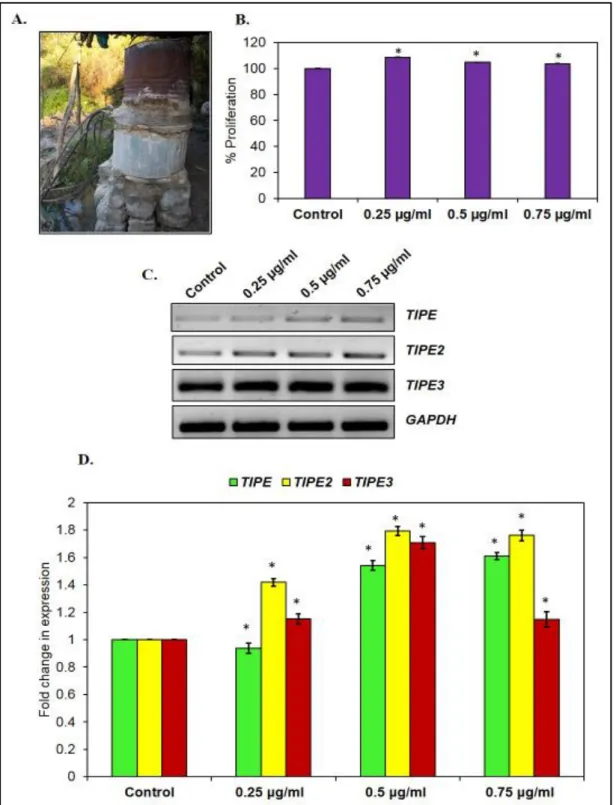
Materials and Methods
- Cell culture
- CRISPR/Cas9 mediated gene knockout
- MTT assay
- Colony formation assay
- Migration assay
- Invasion assay
- Western blot
- Statistical analysis
Briefly, CRISPR/Cas9 scramble, CRISPR/Cas9 TIPE, , CRISPR/Cas9 TIPE1, , CRISPR/Cas9 TIPE2, and CRISPR/Cas9 TIPE3 cells were seeded in 6-well plates at low density (~1000 cells per well). Briefly, CRISPR/Cas9 TIPE, CRISPR/Cas9 TIPE1, CRISPR/Cas9 TIPE2, and CRISPR/Cas9 TIPE3 cells were serum-starved for 18 h before being seeded into well migration chambers.
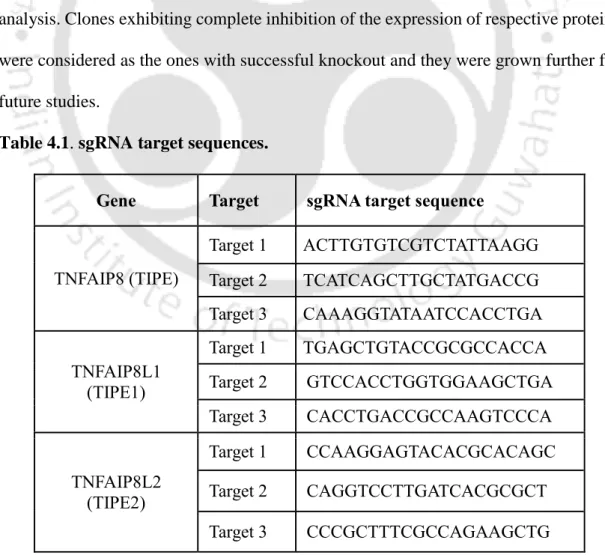
Results and discussion
Confirmation of knock out of TIPEs
Knockdown of TIPE in human lung cancer NCIH460 cells was performed using the CRISPR/Cas9 gene editing method. Effect of TIPE, TIPE1, TIPE2 and TIPE3 knockdown on lung cancer cell proliferation.
Effect of TIPE, TIPE1, TIPE2 and TIPE3 knockout on the proliferation of lung cancer cells
In addition, TIPE was also found to promote the proliferation of lung cancer cells. Effect of TIPE, TYPE1, TYPE2 and TYPE3 knockdown on the clonogenic potential of lung cancer cells.
Effect of TIPE, TIPE1, TIPE2 and TIPE3 knockout on the clonogenic potential of lung cancer cells
Effect of CRISPR/Cas9-mediated knockout of TIPS on survival of lung cancer cells. Taken together, our results indicate that TIPE, TIPE2 and TIPE3 are responsible for the positive regulation of lung cancer cell survival, while TIPE1 negatively regulates the proliferation and survival of lung cancer cells.
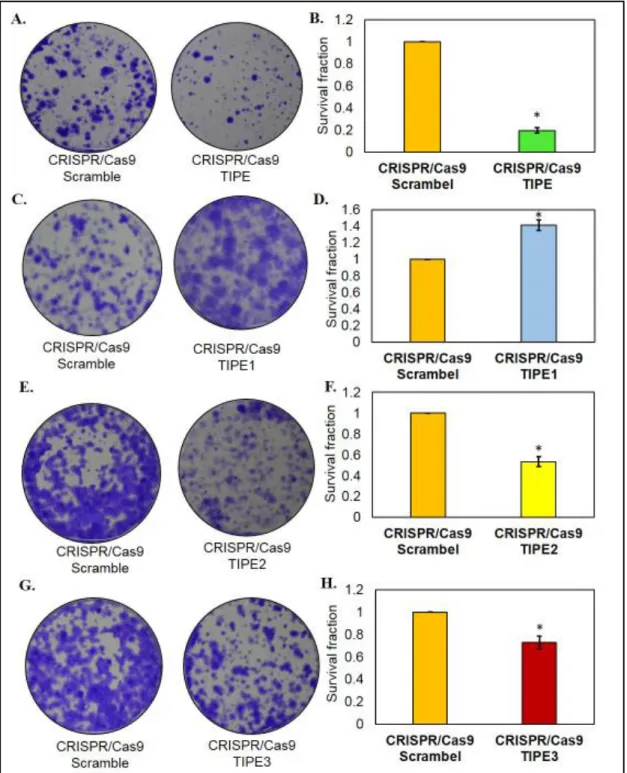
Effect of TIPE, TIPE1, TIPE2 and TIPE3 knockout on the migration of lung cancer cells
Effect of CRISPR/Cas9-mediated knockdown of TIPEs on lung cancer cell migration. Taken together, TIPE proteins appeared to be responsible for the regulation of lung cancer cell migration.
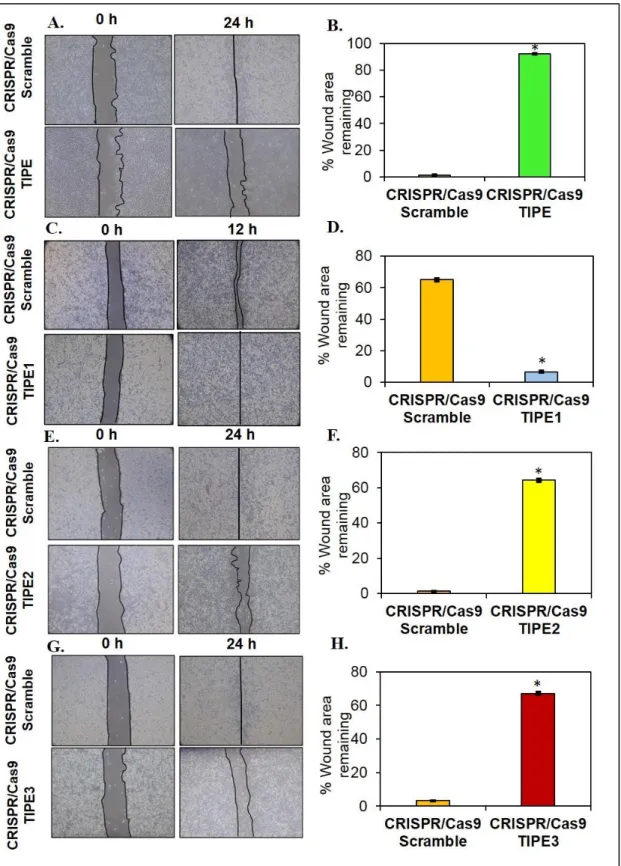
Effect of TIPE, TIPE1, TIPE2 and TIPE3 knockout on the invasion of lung cancer cells
For example, similar to our results, decreased expression of TIPE was reported to inhibit the growth and migration of gastric cancer cells effectively (Li et al., 2015). Furthermore, loss of TIPE resulted in downregulation of Cox-2, which plays an important role in cellular growth, differentiation and inflammation (Erkanli et al., 2007).
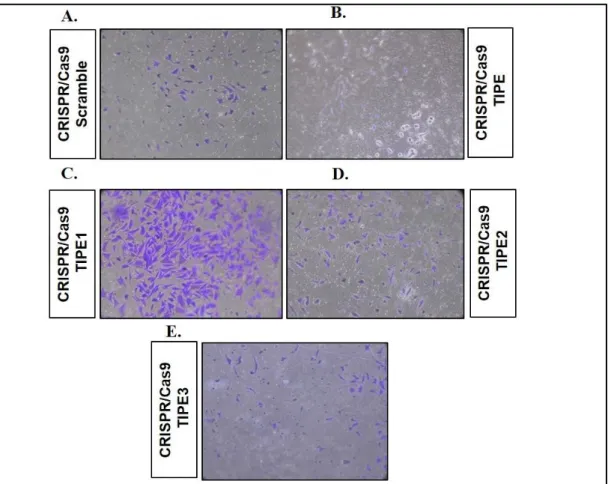
Effect of TIPE1 knockout in the modulation of Akt/mTOR/S6/STAT-3 signaling
Collectively, loss of TIPE1 increased the proliferation, survival, invasion and migration of lung cancer cells through activation of the Akt/mTOR/S6/STAT-3 signaling axis (Figure 4.9). Notably, this is the first report to demonstrate the involvement of the Akt/mTOR/S6/STAT-3 signaling axis in TIPE1-mediated lung tumorigenesis.
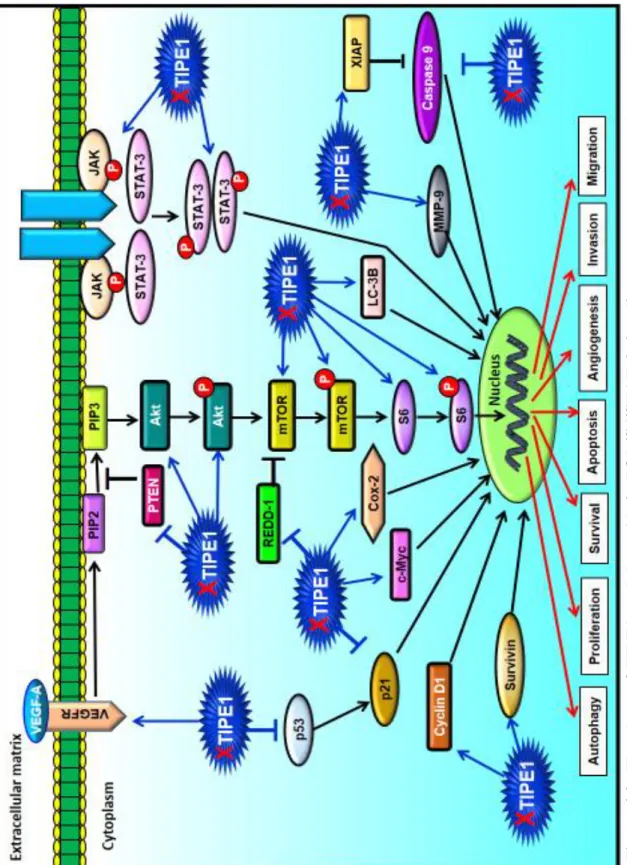
Effect of TIPE2 knockout in the modulation of Akt/mTOR/S6/NF-
Knockout of TIPE2 caused a marked decrease in the proliferation, survival, invasion and migration of human lung cancer cells. Effect of TYPE2 knockout on the expression of proteins involved in cell growth, proliferation, survival and apoptosis regulation, B.
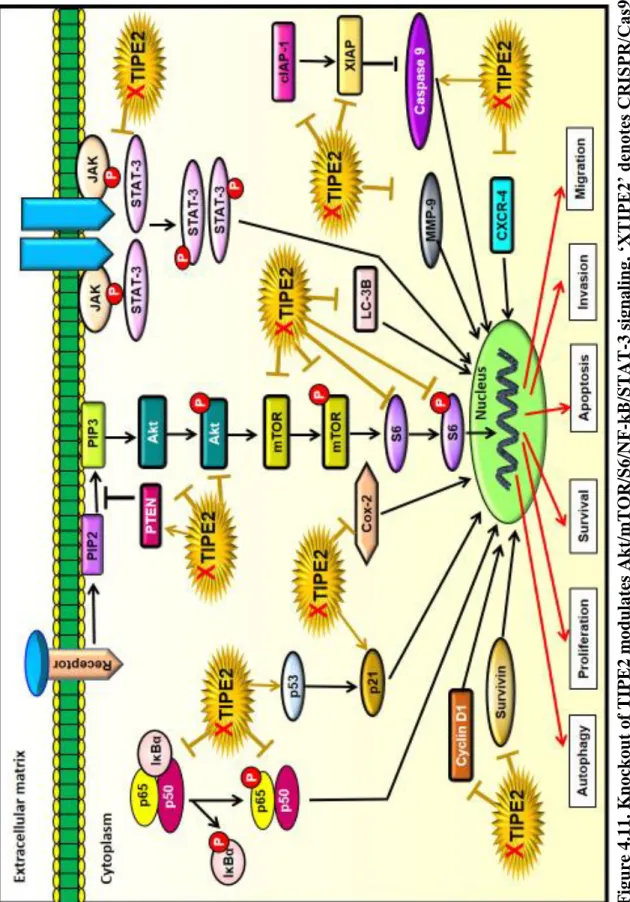
Effect of TIPE3 knockout in the modulation of Akt/mTOR/S6/NF-
- Effect of tobacco components on the clonogenic potential of TIPE, TIPE2 and TIPE3 knockout lung cancer cells
- Effect of tobacco components on the migration potential of TIPE, TIPE2 and TIPE3 knockout lung cancer cells
- Effect of tobacco components on the modulation of different targets in TIPE, TIPE2 and TIPE3 knockout lung cancer cells
- Effect of tobacco components on the modulation of NF-B and NF-B regulated gene products in TIPE2 knockout lung cancer cells
- Effect of tobacco components on the modulation of Akt/mTOR/S6/STAT- 3 signaling in TIPE3 knockout lung cancer cells
Effect of tobacco components on the proliferation of TYPE, TYPE2 and TYPE3 lung cancer cells. Effect of TIPE, TIPE2, and TIPE3 on nicotine and BaP induced survival of lung cancer cells.
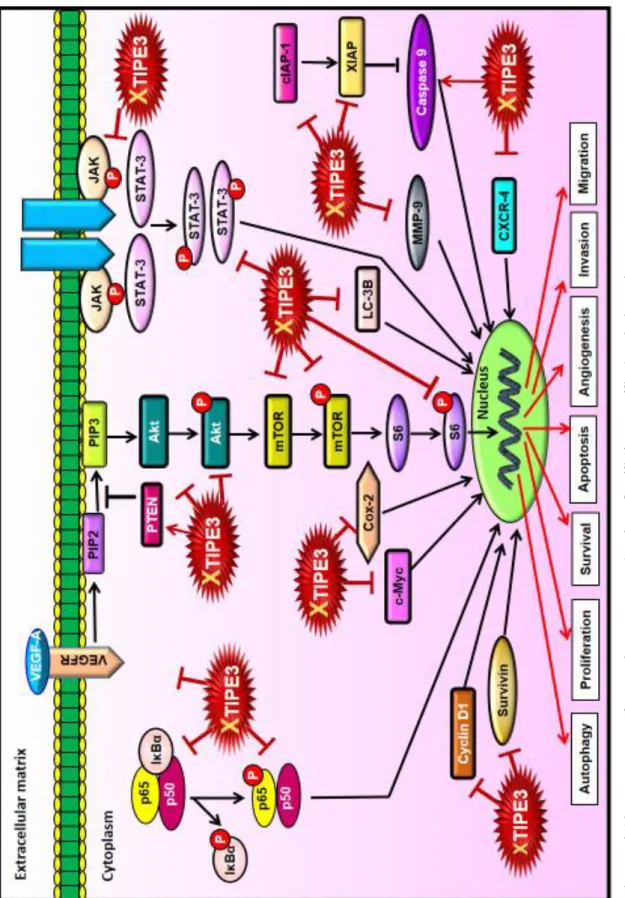
Conclusion
TIPE also promoted invasion potential of lung cancer cells through modulating the Hippo pathway (Han et al., 2018). Further, BaP was also found to promote the proliferation of lung cancer cells effectively (Wang et al., 2015).
Limitations and future prospective of the study
Determining the upstream mediators responsible for the modulation of TIPEs in lung cancer, especially tobacco-induced lung cancer, appears to be of vital importance. In addition, analysis of TIPE's function and role in lung cancer was performed in a single cell line.
Bibliography
Regulation of Sox2 and stemness by nicotine and electronic cigarettes in non-small cell lung cancer. TIPE3 differentially modulates proliferation and migration of human non-small cell lung cancer cells via distinct subcellular location.
List of Abbreviations
LE-AS5: Liposomal formulation of TIPE antisense oligonucleotide. LS-SCLC: Limited stage disease - small cell lung cancer. TIPE/TNFAIP8: Tumor necrosis factor-α-induced protein eight TIPE1/TNFAIP8L1: Tumor necrosis factor-α-induced protein eight like 1 TIPE2/TNFAIP8L2: Tumor necrosis factor-α-induced protein eight like 2 TIPE3/TNFAIP8L3: Tumor necrosis factor-α-induced protein eight like 3 TKI: Tyrosine kinase inhibitor.
List of Tables
